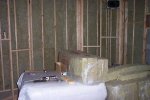Michael Jones
New member
I need to wire in some cables for the rear surround monitors in my studio.
These monitors are passive Event 20/20's. I'll be using a Hafler 1500 series amp to drive them.
The cables I use now (monster) are too short, so I'll need to get or make some new ones.
From the monitors to the amp is approximately 25'. (It goes down from the monitor, along the inside of the wall, thru a cable trough, and to an amp at the console area.)
The monster cables are a pretty heavy guage, not sure what exactly.
Now for the question:
Can I use the Canare Star Quad cables I'm doing everything else with, to drive the monitors from this amp?
The Star Quad cables are twisted pairs of 20 ga. wire. Seems kind of light, gague wise, but I've got lots of it.
I plan to run 2 sets of cables for each monitor.
These monitors are passive Event 20/20's. I'll be using a Hafler 1500 series amp to drive them.
The cables I use now (monster) are too short, so I'll need to get or make some new ones.
From the monitors to the amp is approximately 25'. (It goes down from the monitor, along the inside of the wall, thru a cable trough, and to an amp at the console area.)
The monster cables are a pretty heavy guage, not sure what exactly.
Now for the question:
Can I use the Canare Star Quad cables I'm doing everything else with, to drive the monitors from this amp?
The Star Quad cables are twisted pairs of 20 ga. wire. Seems kind of light, gague wise, but I've got lots of it.
I plan to run 2 sets of cables for each monitor.




 .
.



